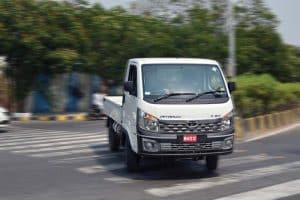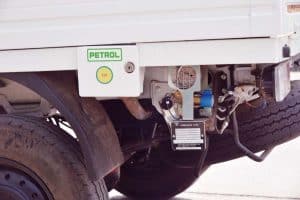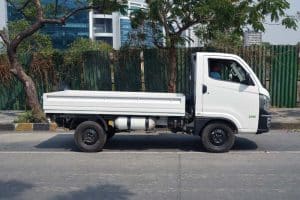Going beyond the minuscule reserve petrol tanks found on CNG trucks, the Tata Intra V20 Bi-Fuel pickup is a breath of fresh fuel. Ashish Bhatia looks at the use case and proposed flexibility for fleet operators.
The Tata V20 Intra Bi-Fuel pickup truck enhanced the Intra range and with it, the SCV-based pickup offerings from Tata Motors Ltd. The Intra range spans from the V10 to the latest generation V50 with a best-in-class power-to-weight ratio and different, rated payload options to choose from. Now RDE-compliant, the V20, claimed to be India’s first bi-fuel truck sits right in the middle of this proven range. The combination of petrol and CNG tanks is what makes the 2.27-tonne Gross Vehicular Weight (GVW) truck an attractive proposition for fleet operators, both small and large, including the owner cum drivers, willing to experiment. It created quite a stir when it was first showcased in Hyderabad, in September 2022. The SCV-based pickup solution is akin to offerings in global markets like Brazil and China compared to other pickup-dominated markets.
The value proposition is to aid the reduction of logistics costs (~14 per cent of GDP in India). The attempt is to hit the sweet spot and offer a low Total Cost of Ownership (TCO) with operational flexibility stemming from a bi-fuel platform. It is to also tap into the 3x headroom of growth in India compared to a global market scale that is 6x of M&HCVs as per Girish Wagh, Executive Director, Tata Motors Ltd.
The operator appeal
The Intra V20 Bi-fuel is equipped with the intelligence to switch over from CNG to petrol in case of low-pressure detection, as one of its Unique Selling Propositions (USP). That apart, imagine being able to switch over, from petrol to CNG, while running, at will, and with just a toggle of a dedicated switch. The green light hints it’s injecting CNG. The light goes off in case of injecting petrol. Different fuel injectors and fuel lines for the two fuel sources are at the core of the bifuel platform. Bifuels have witnessed an acceptance in the yellow plate aggregator vehicles hinting at the growing acceptance and the will to experiment for range and profitability. An Indore-based cabbie Sushant plying his white Accent from Dudh Talai, Malipura, Ujjain to Vijay Nagar, Indore about 60 km swears by this flexibility from his bi-fuel.
The thought process of truck operator Kanhaiya though is a complete contrast to cabbie Sushant. Kanhaiya, a transporter based out of Mumbai does not prefer CNG even in his I&LCV range for intracity requirements. He owns a diesel Intra V10. Into transporting shooting equipment, his bookings are mostly for the long haul (intercity). Here he shuns the idea of petrol in combination with CNG fitting the bill. His wishlist consists of a bi-fuel, powered by diesel and CNG instead. Little does he know that the two pose other challenges and are best left for a debate on another day. Despite the hard-line, he draws, he is compelled to take a second look and does the math in his head before deciding for or against the Intra V20 Bi-Fuel. The aggressive headlamp brow, the signature Tata trust bar and the one-tonne load tray, backed by the ‘Tata Samarh and Sampoorna Seva’ and a two years or 72,000 km warranty have forced a second thought. Mohsin into last-mile deliveries would rather stick to the Intra V30 given his taste and requirements. He claims it to be a choice of many even as he gives the V20 a long stare amid his daily grind. Tata Motors is confident of creating a use case for such hard-to-convince fleet customers among others, more forthcoming.
Driveability
It is natural for fleet operators to be wary at first until they experience the technology and efficiency of the vehicle on their own. Driving the vehicle on behalf of these fleet operators, we took the vehicle on an intracity sojourn. With a majority of the drive carried out on a flat terrain flat, the V20 had no qualms tackling the ascends and then descends either, in both the petrol and the CNG mode. The SCV-pickup boasts a 35-litre petrol tank (E20 blend compliant) and two CNG tanks of six-and-a-half kg and four kg each, respectively equivalent to 110-litre. This combination is claimed to enhance the range of the pickup to go the long haul, an estimated 700 Kms as per company claims. In the real world, multiple factors ought to be considered though.
A Stainless-Steel (SS) tube and fitment of the CNG tank sit under the load tray on the starboard side. The tank is claimed to have been carefully designed keeping safety considerations at the forefront. The factory-fitted tank is assured to prevent a gas leak and in case of a thermal incident production, the Engine Control Unit (ECU) cuts off CNG. Petrol mode takes over. In an era where retrofit kits are a norm, this factory fit offers a higher degree of safety assurance.
The REVTRN18 1.2-litre, three-cylinder, Direct Injection (DI) can be directly started in CNG or petrol as may be desired living up to its tag of offering flexibility. The engine proved to be refined in either of the two fuel modes for most parts of the drive. It’s the near-instantaneous shift between the two fuel sources that impressed the most. The V20 draws 58.8 hp (43.85 kW) at 4000 rpm and a peak-rated torque at 108.34 Nm from 1800-2200 rpm in the petrol mode. In the CNG mode, the engine peaks at 53.4 hp (39.82 kW) at 4000 rpm with a peak-rated torque of 96.45 Nm between 1800-2200 rpm. The engine is mated to a manual synchromesh, five-speed gearbox. It is linked to a dash-mounted shifter that makes the cabin of the V20 a walkthrough cabin like is the case with the entire range.
The shifts are smooth with well-spaced-out gear ratios giving it just the right amount of bite in the mid-range. This helps push the vehicle within the speed-governed range as well as feels light on the pedal. All this while, the gearshift advisor helps to extract optimal performance and maintain the desired fuel efficiency. The V20 is claimed to have a 15-17 kmpl mileage in the petrol mode and up to 21 kmpl in the case of CNG. The semicircular instrument cluster relays such critical information seamlessly. The ride is made more pleasing with the manoeuvrability on offer courtesy of an Electric Power Assisted Steering (EPAS) that eliminates fatigue from the equation. The 5.25m, best-in-class, Turning Circle Radius (TCR) gives that added boost of confidence to lug around the 2690 mm by 1620 mm (8.8 ft. by 5.3 ft.) load tray even on dense urban roads like the ones we encountered.
The vehicle has a good on-road presence. It steers over the rough patches unhindered due to the hydro-formed chassis that elevates the overall sturdiness. The lesser welding joints are a testimony to the growing focus on high-strength structures in a bid to enhance durability. The suspension at the front and the rear is made up of semi-elliptical leaves (four at the front and six at the rear). Since we were plying in an unladen state, understandably, the load tray rattled. It is not the case when laden, assures the company. The 175 mm ground clearance helped glide past the uneven speed breaker gradients. The grade ability at 30 per cent in petrol reduces marginally to 28 per cent in the case of CNG making it apt for the job at hand. The V20 finds a good match in the 165R14 profile, tubeless set of MRF Steel Master M154 tyres.
Bi-fuels, globally are not a new phenomenon. They can be traced back to pickups. The Ford F-series is known to have experimented with bifuel propane (operating on LPG and gasoline) way back in 1998. Back then the tests were favoured towards LPG on the performance front. The fuel economy was found to be optimum with gasoline even then. Even in the case of the Intra V20, in 2023, performance metrics seemed at par and were hard to differentiate on counts like acceleration, braking, driveability or handling. It all boils down to the operator’s TCO math, drive performance vis-a-vis diesel. On the tarmac, the V20 Bi-Fuel proves to be a strong contender for someone willing to experiment. For those cringing about CNG fill times, the flexibility on offer is an attractive proposition. The reserve petrol tank helps top up the range over the minuscule reserve tanks with CNG-only competition.
























